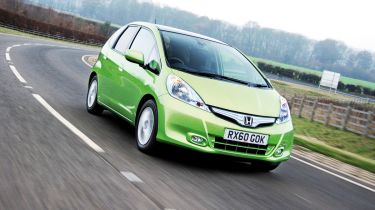Honda Jazz Hybrid
Cheapest petrol-electric car on sale is a clever package, but not without flaws

The Jazz gave Honda a chance to get back to the forefront of hybrid technology. But while it’s efficient, it’s not clean enough. Crucially, it doesn’t qualify for free road tax or exemption from the London congestion charge, plus it’s pricey. That means it’s likely to remain a niche choice – customers wanting low running costs will be better off with an eco-tweaked diesel. In standard petrol form, the Jazz remains a very good choice, serving up practicality to rival a people carrier. The facelift successfully smooths over its rough edges.
It's time for the Jazz to change its tune! The current version of Honda’s popular supermini has only been around since 2008, but it’s already been given a mid-life refresh. And an efficient new hybrid model has been introduced as part of the changes. Is this the best Jazz yet? Auto Express was first behind the wheel to find out.
[[{"type":"media","view_mode":"content_narrow","fid":"69307","attributes":{"alt":"","class":"media-image"}}]]
When it goes on sale in February, the Jazz will be the smallest, cheapest hybrid on the market, costing from £15,995. It uses the same powertrain as the Insight, which pairs a 1.3-litre petrol engine with a 13bhp electric motor for a combined output of 114bhp. It works well. The extra 78Nm of torque from the nickel-hydride battery means the car pulls well in the mid-range, and this offsets the extra 70kg of weight stored in the boot.
Used - available now
Add sleeker aerodynamics and low-rolling-resistance tyres, and the hybrid Jazz manages to return 62.8mpg and put out only 104g/km of CO2 – better than the standard petrol car, but some way short of class-leading small diesels such as VW’s Polo BlueMotion.
Crucially, it won’t be exempt from annual road tax or the London congestion charge, but bosses say a version that emits less than the magic 100g/km is in the pipeline.
Compared to the drivetrain, the rest of the updates are minimal. Honda has sought to improve the overall package without alienating the Jazz’s loyal customer base, so there’s a sleeker front bumper and projector headlights, restyled rear lamps and new chrome trim on the tailgate. Hybrid models also get a unique blue chrome grille.
Under the skin, the suspension has been updated to give a more comfortable ride, but the clever i-SHIFT automated manual box has been ditched in favour of a seven-speed CVT automatic.
On the road, the Jazz does feel more composed, but the ride is still a bit jittery. And although the CVT box works well at low speeds, it’s sluggish under hard acceleration, making for a noisy experience. The steering has been revised to provide more positive feedback at speed, but the wheel is still slightly over-assisted. Mind you, that does make the Jazz easy to manoeuvre around town, and most customers will appreciate the feather-light controls.
Inside, the cabin is starting to show its age. There’s a new set of blue-lit dials and a read-out to show how frugally you’re driving, but the dash plastics are still hard and scratchy, and mark easily.
Refinement is also an issue. At motorway speeds, engine and tyre noise become intrusive, making the Jazz a wearing car to travel in on long trips. And that’s a real shame, considering how spacious and practical the interior is – the boot offers a capacity of 883 litres with the rear seats folded, and the squabs can even be popped up for carrying tall objects.
Ultimately, though, Jazz hybrid buyers will have to be completely sold on the rather modest efficiency gains that the car provides in order to justify the price. At £18,435, this flagship HX model costs £750 more than the equivalent Jazz 1.4 EX CVT.











